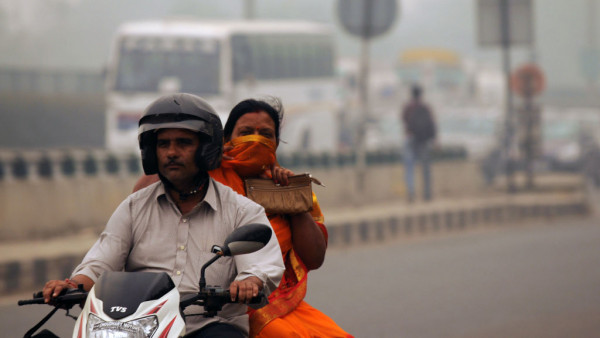A dystopian South Asian sky reveals itself through satellite images as smog and seasonal air pollution engulf northern India (Delhi, NCR, Haryana, and Punjab) and southern Pakistan’s Punjab province.
While pollution has always been a concern, air pollution in the Global South has become especially catastrophic in recent years, worsening during the winter months and bringing public life to a standstill in major cities like New Delhi, Lahore, and Multan.
Experts attribute the crisis to industrial pollution, massive vehicle emissions, and the burning of crop stubble in Haryana and Uttar Pradesh in India, as well as in both Punjab provinces across the border.
Unable to do much to counter the crisis, India and Pakistan have been inadvertently united by smog, often called a silent killer.
As winter sets in, the administrations of Lahore and New Delhi have been forced to periodically close primary schools and impose penalties on commercial establishments that exceed pollution limits.
That said, both cities continue to record dangerously high levels of PM 2.5, a harmful particulate matter, with reports showing that the border areas of Punjab, Pakistan, have experienced the highest pollution levels since the early 1900s, while New Delhi has consistently ranked among the world’s most hazardous cities.
As severely impacted states consider the possibility of ‘smog diplomacy,’ The New Arab explored the crisis by speaking with environmental experts.
Understanding the drivers of air pollution
“Air pollution has been an issue for long. In the last decade, the issue has come sharply into focus, especially during autumn and winter when levels of pollutants such as fine particulate matter (PM2.5) are particularly high. There’s increasing availability of data on air quality, the ability to track and visualize satellite imagery, and a growing public discourse on the topic,” began Dr Pallavi Pant, an air quality scientist and the lead for the Global Health Programme at the Health Effects Institute.
Pallavi’s view is supported by Ahmad Rafay Alam, a former Yale World Fellow and environmental lawyer in Lahore, who has been central to climate and environmental discussions in Pakistan.
In his own words, Ahmad explained, “The causes of air pollution are year-round, so there is poor air quality year-round.
The Environmental Protection Agency, Punjab has had a few air pollution monitors operating in Lahore, but it wasn’t until 2017 that they were ordered by the Lahore High Court to put the monitor data online.
The Pakistan air quality initiative also began installing monitors in Pakistani cities around 2016. These privately owned monitors broadcast Air Quality Index (AQI) online and have been the reason the press has reported air pollution in Lahore.”
In light of Pallavi’s and Ahmad’s comments, global reports confirm air pollution as one of the most pressing environmental threats to human health, causing an estimated 8.1 million premature deaths in 2021, with its severity particularly pronounced in South Asia in recent years.
Pallavi explained this from a meteorological perspective: “Changes in levels of air pollution are affected by two key factors: the amount of pollution being emitted into the atmosphere, and the local meteorological conditions such as wind speed, temperature, relative humidity, and so on.
“During the autumn and winter seasons, wind speeds tend to be low, and temperatures are also low. In addition, Delhi and other parts of Northern India experience what are known as thermal inversions.
“What happens during a thermal inversion is that warm air rises up and traps colder air closer to the ground. This, in turn, means that the air pollution is not as easily dispersed. As a result, pollution levels can continue to build up until the meteorological conditions improve.”
On the other hand, Ahmad linked the rise in air pollution to industrialisation: “It appears the main contributors to year-round air pollution are automobile emissions, industrial emissions, and the emissions from fossil-fuel energy plants.
“As cars, industry, and energy emissions have increased, air pollution has surpassed the carrying capacity of the airshed surrounding the northern parts of the North Indian Subcontinent.
“Of course, the contribution of crop burning also makes things worse, but crop burning occurs for only 2–3 weeks a year and isn’t a year-round contributor.”
What’s working and what’s not
Given that this year has been particularly catastrophic for both countries, one might wonder what measures have been initiated or implemented by the federal and local governments in both India and Pakistan.
Pallavi centered her response on the plans and strategies implemented by the Indian government: “In 2019, the national government introduced the National Clean Air Programme, or NCAP, which set a target to reduce PM2.5 and PM10 levels by 40% by 2026 compared to 2017. The plan focuses on 131 non-attainment cities, i.e., cities that are not in compliance with the Indian National Ambient Air Quality Standards. India also leapfrogged from Bharat Stage IV (Euro IV equivalent) to Bharat Stage VI (Euro VI equivalent) vehicle emission standards in 2020.”
Beyond these plans, in India, where the AQI is considered hazardous above 400 (with the recommended range being 0-100), the government has shut down schools and offices, instructing everything to move online. It has also banned all non-essential construction activities in Delhi and surrounding areas. Additionally, water tankers have been deployed to spray water in an attempt to settle the dust. Similar measures have been taken by Pakistan’s Punjab government.
“The Government of Punjab usually seals a few dozen industrial units in Lahore and files criminal cases against farmers accused of crop burning. Sometimes they close down educational institutions,” Ahmad elaborated on the administrative measures typically taken.
“This year, a brief ‘lockdown’ was put into place, shutting down industrial and commercial activity for a few days. There is some media attention, but soon a winter wind or rain dissipates the haze — and although the AQI remains high, the problem is kicked over to the next ‘smog season.’ The Government of Punjab’s approach to air pollution is flawed, as it sees the problem as a seasonal issue afflicting Lahore, rather than the year-round regional public health emergency it is,” Ahmad added.
Understandably, with a combined population of 1.428 billion in India and 240.5 million in Pakistan, air pollution has not been an easy battle.
Although both governments have issued advisories urging people to stay indoors and use masks and air purifiers, Pallavi and Ahmad do not view these measures as foolproof solutions.
Pallavi remarked, “Outdoor air purifiers or anti-smog mist guns or water cannons are not a viable solution for clean air. We know that improvements in air quality are driven largely through reduction of emissions at the source. On the other hand, air purifiers, if used indoors, can help reduce exposures, especially for those at higher risk, such as older people, pregnant women, children, or people living with chronic heart disease or asthma.”
Meanwhile, Ahmad said, “Air purifiers don’t work on this scale. They’re bad science and a waste of time and money.”
The urgent need for regional cooperation
Given these catastrophic conditions, ‘smog diplomacy’ could be a powerful way to address the escalating air pollution crisis during the autumn and winter months.
Pallavi seems hopeful, viewing air pollution as a “regional challenge in South Asia.”
She believes in “a consistent and coordinated approach to address air pollution, not just for India and Pakistan, but across South Asia.”
This, she argues, can help bolster clean air action.
She added that “regionally coordinated action can also provide better value for money.”
For example, she noted, “across India and Pakistan, there continue to be challenges in the context of air quality monitoring, which can provide good grounds for transboundary cooperation.”
For Pallavi, this cooperation would allow both countries to leverage technical expertise and resources to foster better data collection.
Her perspective resonated with Ahmad, though in a slightly different manner.
“I don’t think ‘smog diplomacy’ will be a tangible solution to air pollution. But it will provide a platform for both countries to open a new line of dialogue outside the toxic narrative built over the past decade or so. It may serve as a confidence-building exercise that can translate into a number of other positive results,” Ahmed said.
Looking to the future, the success of ‘smog diplomacy’ will depend on time, political vision, commitment, and collaboration, while ongoing public awareness and education will remain critical.
A key factor that needs to be addressed is the growing number of cars in India and Pakistan. For many, owning a fancy car is considered a life goal, and while it may be an individual aspiration, when it becomes the dream of millions, it contributes significantly to traffic emissions.
Equally important is the need to confront and treat air pollution as a serious threat.
India, Pakistan, and their neighboring countries, Nepal and Bangladesh, are facing the highest public health and environmental risks, and whether or not ‘smog diplomacy’ succeeds, these nations must tackle air pollution head-on.
If they continue with narrow approaches and hesitate to collaborate, the consequences could be irreversible.
Nilosree Biswas is an author, filmmaker, and columnist who writes about the history, culture, food and cinema of South Asia, the Middle East, Asia and its diaspora


